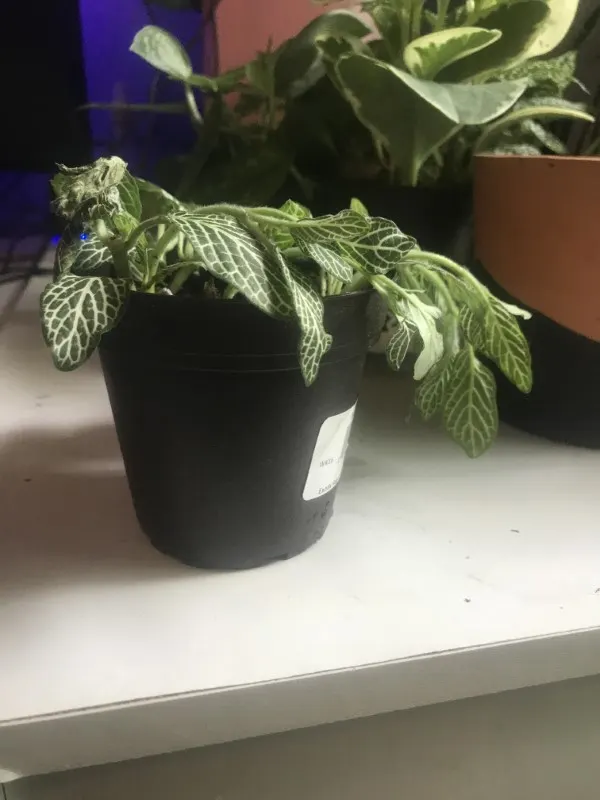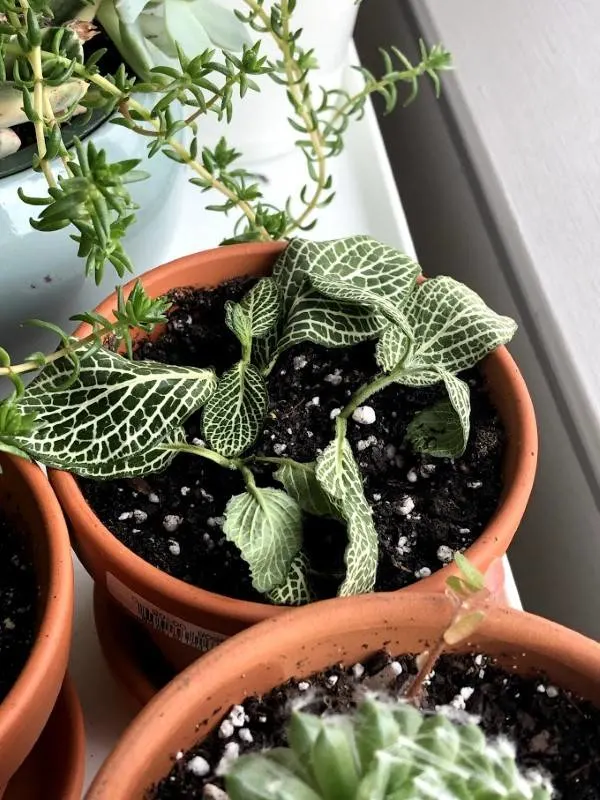Owners of the nerve plant would agree that there’s nothing worse than seeing your nerve plant droop. It’s even more heartbreaking to know you provided these plants with tender loving care. However, there are times when our plant care techniques need a little tweaking to keep our nerve plants healthy.
Several plants require a higher level of care to ensure vibrant foliage, and the nerve plant is no different. It is native to the steamy rainforests of the world and therefore enjoys humidity, warmth, and dappled lights. Therefore, if you’re asking, ‘why is my nerve plant drooping?’ you’re in the right spot.
There are many reasons why your nerve plant could be drooping, and they include poor soil, poor watering schedule, low humidity levels, sudden temperature drops, insufficient lighting, and many more.
In this article, you’ll learn the common reasons why your nerve plant is drooping and how you can ensure you never have to experience another droopy day with your nerve plants again.

Why Is My Nerve Plant Drooping?
The nerve plant is also known as the Fittonia Albivenis. It offers delicate green foliage that also features white-silvery veins. However, it is pretty easy to find this plant drooping. Below are some common reasons why and how you can fix them.
1. Underwatering
Nerve plants are tropical plants and therefore require moist soil. Do not let the plants fully dry out between soaking as it doesn’t bode well for the plant. You’ll often notice that the first sign of underwatering that the nerve plant displays are drooping leaves. When this happens, you need to take precautions to get your nerve plant thriving again.
How to Fix
Once you discover that your plant is drooping because of underwatering, soak the plant with enough water and let the excess water drain away from the bottom of the container. You should water the nerve plant every two days on warm days because warm indoor temperatures cause the nerve plant soil to dry out quickly.
You should also ensure that the potting soil drains out quickly to prevent soggy soil, leading to root rot. To confirm that the plant’s soil isn’t dry, you should use your finger to touch the top of the soil.
After watering, allow the plant to recover for a day. If you don’t see any improvement, the chances are that there’s another reason why your nerve plant is drooping.
2. Overwatering
Although underwatering is an answer to ‘why is my nerve plant drooping?’ another common reason is overwatering. Excess water usually leads to drooping nerve plants, followed by yellow leaves and root rot.
Therefore, when watering your plant, especially when trying to prevent underwatering, you mustn’t let your plant sit in water all day. This is usually a good condition for pests to live in and root rot to develop.
How to Fix
Allow the top layer of your nerve plant soil to dry out slightly before watering it again to fix this issue. After the watering session, ensure that the excess water drains out from the soil.
Once it successfully drains out into the drip tray, tip the water out to avoid having your nerve plant sit in the water. This would prevent overwatering and the possibility of root rot.

3. Lack of Humidity
Another common answer to ‘why is my nerve plant drooping’ is the lack of humidity. As a plant that is native to the steamy and humid rainforest, the rainforest provides the nerve plant with lots of natural humidity.
When deprived of this, it could cause the nerve plant to droop as a sign of distress. It reacts badly to dry air when growing. This is a common occurrence when you grow your nerve plant indoors. The central heating and air conditioning system could dry the air and cause the nerve plant to start drooping.
How to Fix
To facilitate humidity when growing your nerve plant, you should mist the plant regularly. You could achieve this using a spray bottle. Alternatively, you could get a humidifier and place the nerve plant next to it to raise its humidity level.
Another option for you to prevent the lack of humidity level is to stand the plant on a pebble tray filled with water. However, you need to ensure that the water doesn’t touch the bottom of the plant container. You can also place other plants around the nerve plant to naturally increase its humidity level.
- IMMEDIATE DRY AIR RELIEF! Want to eliminate the suffering from the terrible effects of dry air? No need to struggle with cheap flimsy and leaky desk humidifiers. This quality ultrasonic humidifier is the one you’re looking for. It pumps relief immediately and effectively! – Feel better in minutes!
- OPERATES IN TOTAL SILENCE – SLEEP LIKE A BABY! No humming, whistling, or crackling as this durable Whole-House Humidifier steadily and efficiently dispenses the soothing cool mist you crave. SLEEP better, BREATHE better, LIVE better! You’ll wish you found this years ago!
- MULTIPLE MIST SETTINGS + 360 DEGREE ROTATING NOZZLE – This Humidifier was created with YOU in mind. Your environment, your needs, and your preferences! Designed with a super simple control dial and 360° rotating nozzle so that you can fully control and customize the mist output and mist flow direction. AUTOMATIC SHUT OFF- No need to babysit this Humidifier. We know you’ll want to shut this off before the tank runs out... Rest assured you can SET IT AND FORGET IT!
- 2.2L LARGE WATER TANK – FILTER FREE- FEATURES A LIFTIME WARRENTY! Made with an impressive 2.2L super large water tank that keeps your Room-Humidifier right on chugging for over 24 hours on a single fill! Designed
- FEATURES A LIFTIME WARRENTY! Made with an impressive 2.2L super large water tank that keeps your Room-Humidifier right on chugging for over 24 hours on a single fill!
4. Incorrect Amount of Light
Two conditions that ail the nerve plant and cause it to droop are low or too much light. When you expose the nerve plant to too much light, it could cause the leaves to droop and burn.
The nerve plant initially grows on the forest floor beneath the shady fronds of tall plants in the rainforest. Therefore the plant prefers medium and low light conditions.
How to Fix
The ideal method to fix this issue is to place it where it can receive indirect sunlight because it cannot tolerate direct sunlight. For example, you can move it to a west or east-facing windowsill to ensure the plant receives ample indirect sunlight.
You can also utilize a fluorescent light to improve its low-lit condition. Alternatively, a sheer curtain can ensure the plant is safe but direct sunlight and receives ample indirect sunlight. If this is the issue, your nerve plant might need two to three days to recover.
5. Incorrect Temperature
Another suitable answer to the question ‘why is my nerve plant drooping?’ is incorrect temperature. The nerve plant does not enjoy cold drafts and will show its distress by drooping.
They thrive in warm climates and usually struggle to grow in cold drafts. If there is cold air coming through cracks in the windows or doors, you should move your nerve plant out of the way as it could shock and damage the plant.
A nerve plant growing in a room with cold air is at a higher risk of developing root rot and being overwatered. In such conditions, your plant won’t require much water, and the soil will take longer to dry out.
How to Fix
Nerve plants usually enjoy the temperate and cozy temperature indoors. The ideal temperature range for growing a nerve plant is 60 – 79°F. This temperature range encourages the growth of your nerve plant and will prevent the drooping of its leaves.
You should also move the nerve plant to a warmer location that shields it from the window’s open doors or cold drafts.
However, resist the temptation of placing your plant near a heater or the central heating system. Doing this will cause the soil to dry out and lead to the drooping of its leaves.
Final Thoughts
These are the most common answers to why my nerve plant is drooping?’. Trying to figure out the symptoms to determine which of these is the reason why.
By catching the problem early, you can implement the solutions shared in this article to solve the issue. It may take days or weeks for your nerve plant to look normal again, so you must be patient.

